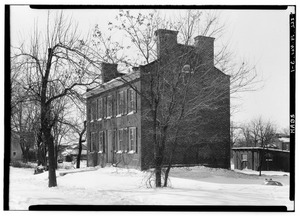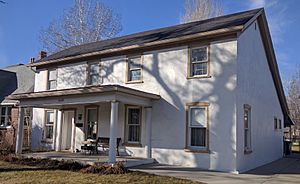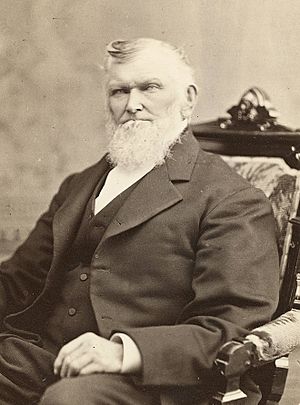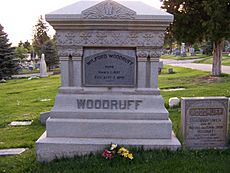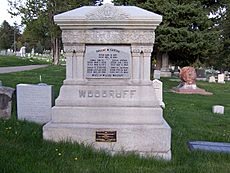Wilford Woodruff facts for kids
Quick facts for kids Wilford Woodruff |
|
|---|---|
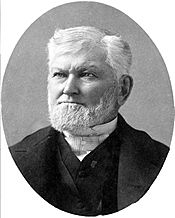
Woodruff in 1889
|
|
| 4th President of the Church of Jesus Christ of Latter-day Saints | |
| April 7, 1889 – September 2, 1898 | |
| Predecessor | John Taylor |
| Successor | Lorenzo Snow |
| President of the Quorum of the Twelve Apostles | |
| October 10, 1880 – April 7, 1889 | |
| Predecessor | John Taylor |
| Successor | Lorenzo Snow |
| End reason | Became President of the Church |
| Quorum of the Twelve Apostles | |
| April 26, 1839 – April 7, 1889 | |
| Called by | Joseph Smith |
| End reason | Became President of the Church |
| Apostle | |
| April 26, 1839 – September 2, 1898 | |
| Called by | Joseph Smith |
| Reason | Replenishing Quorum of the Twelve |
| Reorganization at end of term |
Rudger Clawson ordained |
| Personal details | |
| Born | March 1, 1807 Farmington, Connecticut, United States |
| Died | September 2, 1898 (aged 91) San Francisco, California, United States |
| Resting place | Salt Lake City Cemetery 40°46′33″N 111°51′45″W / 40.77592°N 111.86247°W |
| Spouse(s) |
Phebe Whittemore Carter
(m. 1837; d. 1885)Mary Ann Jackson
(m. 1846; div. 1848)
(m. 1878; d. 1894)Sarah Elinor Brown
(m. 1846; div. 1846)Mary Caroline Barton
(m. 1846; div. 1846)Mary Meeks Giles Webster
(m. 1852; d. 1852)Clarissa Henrietta Hardy
(m. 1852; div. 1853)Emma Smith
(m. 1853)Sarah Brown
(m. 1853)Sarah Delight Stocking
(m. 1857)Eudora Young Dunford
(m. 1877; div. 1879) |
| Children | 34 (including Abraham O. Woodruff and Clara W. Beebe) |
| Parents | Aphek and Beulah Woodruff |
| Signature | |
Wilford Woodruff Sr. (March 1, 1807 – September 2, 1898) was an American religious leader. He became the fourth president of the Church of Jesus Christ of Latter-day Saints (LDS Church) in 1889 and served until he passed away. In 1890, he made the important decision to end the public practice of plural marriage among church members.
Woodruff joined the Latter Day Saint church as a young adult. He met Joseph Smith, the founder of the Latter Day Saint movement, in Kirtland, Ohio. He then joined a group called Zion's Camp in April 1834. He stayed in Missouri as a missionary, teaching in Arkansas and Tennessee. After returning to Kirtland, he married his first wife, Phebe. He also served a mission in New England.
In July 1838, Joseph Smith asked Woodruff to be a member of the Quorum of the Twelve Apostles. He was officially made an apostle in April 1839. Woodruff served a mission in England from 1839 to 1841. He helped many new church members from England travel to Nauvoo. When Joseph Smith passed away, Woodruff was away promoting Smith's presidential campaign. After returning to Nauvoo, he and Phebe went back to England. There, Woodruff continued to preach and support local church members.
The Woodruffs returned to the United States just before church members had to leave Nauvoo. Woodruff helped oversee forty families in Winter Quarters. He joined the first group that traveled to the Salt Lake Valley in 1847. After returning to Winter Quarters, Woodruff and Phebe led the Eastern States Mission.
Woodruff and his family arrived in Salt Lake City on October 15, 1850. He built homes, farmed, and raised cattle. He served in the Utah territorial legislature and was very active in his community. He worked as an Assistant Church Historian and later as Church Historian from 1856 to 1889. In 1877, he became the first president of the St. George Temple. There, special temple ceremonies called endowments were performed for both the living and the dead.
Woodruff helped make temple ceremonies more consistent. He also said that church members could perform temple work for anyone they could identify by name. He also changed the practice of sealing members to unrelated priesthood holders. He taught that sealings should follow family lines. In 1882, Woodruff went into hiding to avoid being arrested. This was because of a law called the Edmunds Act, which made it illegal to live with multiple wives. In 1889, Woodruff became the fourth president of the LDS Church.
The government took away voting rights from polygamists and women in Utah Territory. They also took control of church properties, which threatened to include temples. Because of this, Woodruff issued the 1890 Manifesto. This document officially ended the church's support for new plural marriages. Woodruff passed away in 1898. His detailed journals are an important record of Latter Day Saint history.
Contents
Wilford Woodruff's Early Life and Conversion
Wilford Woodruff was one of four sons born to Beulah Thompson and Aphek Woodruff. His mother, Beulah, passed away in 1808 when Wilford was only 15 months old. His father, Aphek, married Azubah Hart in 1809. In 1826, Aphek lost his mill, and the family moved to Farmington, Connecticut.
Wilford went to school until he was 18, which was unusual for the time. He survived serious illnesses and many accidents. At age 20, Woodruff left home to manage a flour mill for his aunt. For three years, he operated mills for others. In 1832, he moved to Richland, New York, with his brother, Azmon. While working at the mills, he studied religion and became interested in a movement called Restorationism.
Woodruff was baptized by a local Baptist minister, Mr. Phippen, but did not join the local church. He joined Joseph Smith's original Church of Christ on December 31, 1833. He was impressed by how the missionaries preached voluntarily and how they claimed to heal the sick.
Missions and Becoming an Apostle
In April 1834, Woodruff left his home in Richland to join Zion's Camp. He met important church leaders, including Joseph Smith, in Kirtland, Ohio. Then, he traveled with Zion's Camp to Missouri in May. When Zion's Camp left Missouri, Woodruff stayed to help church members there.
He was ordained as a priest in 1834 and chose to serve a mission. After giving all his belongings to the church, Woodruff left Kirtland on January 12, 1835. He preached without money or supplies in Arkansas and Tennessee. He mostly preached in small towns and villages. In June 1835, he was ordained as an elder. In February 1836, he learned that Joseph Smith had called him to be a member of the Second Quorum of the Seventy.
Woodruff was very dedicated to the Latter Day Saint church. This dedication sometimes created distance from his family, who did not believe in the church. He returned to Kirtland in November 1836. There, he studied Latin and Greek at the Kirtland School, a school for adults. In January 1837, Joseph Smith called Woodruff to join the First Quorum of the Seventy.
Mission to England and Ordination
On May 30, 1837, Woodruff left Kirtland with Jonathan Hale and Milton Holmes for a mission in New England. He baptized some of his relatives in Farmington, Connecticut, which brought him great joy. During this mission, Woodruff baptized over 100 people. In 1838, Woodruff led a group of 53 church members in wagons from Maine to Nauvoo, Illinois.
In July 1838, Joseph Smith called Woodruff to be a member of the Quorum of the Twelve Apostles. He was officially ordained in April 1839 in Far West, Missouri. In 1839, he and John Taylor were the first apostles to leave from the Nauvoo area for missions in Britain. Woodruff preached in Staffordshire and Herefordshire, England. Almost all the members of a group called the United Brethren converted to Mormonism.
Missionary work in England was very successful outside of London. By August 1840, there were about 800 members. Many converts from England later moved to join other church members in the United States. When Woodruff left England in April 1841, 140 members traveled with him to New York. Woodruff met Phebe in Maine, and they traveled to Nauvoo together in October 1841.
Life in Nauvoo and Winter Quarters
In Nauvoo, the Twelve Apostles asked Woodruff to help with the church's business matters. He became a co-manager of the Times and Seasons newspaper in February 1842. He also helped publish a general newspaper called Nauvoo Neighbor. He bought and sold land, worked in a store, and farmed. He was a member of the Nauvoo city council and a chaplain for the Nauvoo Legion, a local militia. He also helped organize the Nauvoo Masonic Lodge.
As an apostle, he was part of the Council of Fifty. In May 1844, Woodruff left on another trip to preach and support Joseph Smith's presidential campaign. He learned of Smith's death on July 9.
The apostles asked Woodruff and Phebe to serve a mission in England together. They left Nauvoo in August 1844. Woodruff worked to balance the mission's financial records and visited church groups throughout the United Kingdom. He helped establish the authority of the apostles after Smith's death. The Woodruffs left England in January 1846.
Before leaving Nauvoo, Woodruff and Orson Hyde dedicated the temple on April 30, 1846. Woodruff oversaw 40 families who stayed at Winter Quarters. Many people became sick there. Woodruff joined a group that left in April 1847 to find a new place to settle. They arrived in the Salt Lake Valley on July 24 and immediately planted crops. Woodruff returned to Winter Quarters on October 31. The apostles then asked Woodruff to lead the Eastern States Mission, based in Boston. Woodruff led 200 church members traveling west starting in February 1850. They arrived in the Salt Lake Valley on October 15.
Settling in Utah
When Woodruff first arrived in Utah, he focused on building cabins, farming, and raising cattle. He tried growing different types of wheat. He also tried selling goods from outside Utah, but this was not successful. By 1856, he focused mainly on farming and herding.
In 1852, Woodruff began serving as the church historian. He also adopted an orphaned Paiute boy named Moroni Bosnel in 1855.
Woodruff served many terms in the Utah territorial legislature. He was a member of the legislative house from 1851 to 1854. Then, he served in the legislative council from 1854 to 1876. Woodruff supported public schools. He was also part of the 1862 Utah Constitutional Convention. This group tried to get Utah approved as a state, but it failed. Woodruff also served on the Provo City Council in 1868 and 1869.
Woodruff was on the Board of Regents for the University of Deseret. He led a committee to create spelling books using the Deseret Alphabet. In 1854, he spent time teaching his own children at home before public schools were common. He was also president of the Deseret Horticultural Society, which aimed to find the best trees and bushes to grow. By 1857, he had grown over 70 kinds of apples, along with apricots, peaches, grapes, and currants. His products often won prizes at the Utah Territorial Fair. Woodruff led the Deseret Agricultural and Manufacturing Society from 1862 to 1877. This group encouraged new farming methods and shared knowledge about what plants grew well in the territory.
Woodruff sometimes led ceremonies in the Endowment House after it was built in 1855. He performed sealings and endowments every Saturday from 1867 to 1868. He also served a "home mission" to encourage members to renew their commitment to their religion. During the Utah War, he moved his family south to Provo in April 1858. They moved back to Salt Lake City in July.
Woodruff was a founding director of Zion's Cooperative Savings Bank in August 1871. He was also on the board of directors for ZCMI, a church-owned department store. When Brigham Young set up United Order communities in 1874, Woodruff helped organize them in several towns. Most of these programs stopped after a few months. Woodruff started keeping bees in 1870 and founded a society for beekeepers in Utah that year.
Temple Work and Leadership Changes
Starting in 1877, Woodruff was the first president of the St. George Temple. This was the first temple where endowment ceremonies were performed for people who had passed away, as well as for the living. Under the direction of Brigham Young, Woodruff was key in making these ceremonies available for the dead. He also helped standardize the temple ceremonies and gave talks to help people understand them better.
In February 1877, Woodruff received a special message. It said that church members could perform temple work not only for their own relatives but also for anyone they could identify by name. Woodruff spent his 70th birthday working in the temple in 1877. He was baptized on behalf of the signers of the U.S. Declaration of Independence and other Founding Fathers. He said that the spirits of these men had visited him.
After Brigham Young passed away in August 1877, John Taylor became the new president of the church. Woodruff became president of the Twelve Apostles. In 1879, a church leader named George Reynolds was found guilty of polygamy by the U.S. Supreme Court. Federal officials began looking for Woodruff, so he went to live in hiding in Nevada, Arizona, and New Mexico.
A new court ruling in 1882 made it easier to prove "unlawful cohabitation," which was living with multiple wives. Church leaders advised men in polygamous marriages to live with only one wife. In 1884, the government began prosecuting polygamous men more strictly. Woodruff went into hiding in St. George in 1885 and sometimes wore a dress and sunbonnet as a disguise. He was able to visit his wife Phebe before she passed away on November 9, 1885. However, fearing arrest, he did not attend her funeral. After Phebe's death, he lived at Emma's house or with friends.
President of the Church
After John Taylor passed away in July 1887, Woodruff became the leader of the church as the most senior member of the Quorum of the Twelve Apostles. He wanted to reorganize the First Presidency right away. The Quorum agreed in April 1889, and Woodruff became the fourth president of the church.
During Woodruff's time as president, the church faced many legal challenges with the United States government. A law from 1862 made it illegal for religious groups to own property worth more than $50,000 in any territory. Another law in 1887 allowed the government to take church property. The government took control of the temple block and other church offices. The church had to pay to rent these properties back.
Federal judges also stopped approving citizenship for Mormon immigrants in Utah Territory. They claimed that Mormons did not respect federal law. In response, church leaders wrote a statement in December 1889. This statement said that the church did not have the right to overrule civil courts. It also denied certain teachings that former members had claimed.
The 1887 law also took away the right to vote from practicing polygamists and all women in Utah. In June 1890, the First Presidency told church officials that leaders were no longer allowed to perform plural marriages in the United States. A new federal official threatened to take control of the temples in Logan, Manti, and St. George.
Because of these challenges, Woodruff issued the 1890 Manifesto. This document officially ended the church's support for new plural marriages. After the manifesto, a judge said that no more church property would be taken. Woodruff further clarified that men with plural wives should "cease associating with them."
Some historians believe that Woodruff's decision to stop polygamy was a big step for the church. It helped the church move from being isolated to being more accepted.
Temple Changes and Economic Efforts
Before Woodruff's presidency, church members sometimes sealed their relatives to a family member or friend who held the priesthood. This was because Brigham Young had said that all marriages before the church was restored were not valid. Woodruff and other leaders disagreed with this practice.
In April 1894, Woodruff announced a new policy. Individuals should only be sealed to their direct ancestors. He also encouraged members to "trace their genealogies as far as they can." Woodruff helped create the Genealogical Society of Utah to help church members complete these family sealings. He also said that widows could be sealed to their deceased husbands, even if their husbands had not heard the gospel. Woodruff said this change was not new doctrine, but a clarification of earlier teachings. He also encouraged the presidents of the four temples in Utah to coordinate their temple procedures in 1893.
An economic downturn in 1891, followed by a depression in 1893, affected the church's finances. The church was unable to pay its employees' salaries for several months in 1893. Woodruff tried to boost the economy with various projects. This included the Utah Sugar Company, which caused debt for the church. The church also supported local industries like coal and iron mining, the Saltair resort, and the state's first hydroelectric power plant. The church completed and dedicated the Manti and Salt Lake temples during his time as president. Woodruff also established Bannock Academy in Rexburg, Idaho, which later became Brigham Young University–Idaho.
Political Guidelines
In 1895, two church leaders, Moses Thatcher and B. H. Roberts, attended a state meeting as Democrats. Roberts was against women getting the right to vote, but Woodruff and the First Presidency supported it. Thatcher had health issues and often missed meetings. He ran for the Senate as a Democrat. Other church leaders felt he should have asked them before accepting the nomination. Thatcher argued that the First Presidency could not limit a member's political choices.
At a church meeting, a leader named Joseph F. Smith said that anyone in a full-time church position should get permission from their church leaders before seeking a political office. This caused controversy. In response, Woodruff published a statement saying that the church did not want to interfere with members' political activities.
In December 1895, Woodruff said that Thatcher and Roberts would not be presented for a traditional vote of approval at the next church conference unless they changed their stance. Utah became a state with a Republican majority. George Q. Cannon wrote a "Political Manifesto" at Woodruff's request. It stated that religion and politics had always been separate in the church. However, it also said that people in full-time church positions should get approval from the First Presidency before accepting a political nomination. All members of the First Presidency and Quorum of the Twelve signed it, except for Thatcher. After several attempts to resolve the issue, Thatcher was removed from his position as an apostle.
Wilford Woodruff's Family Life
Wilford Woodruff was married to ten women, though not all at the same time. He had 34 children with six of his wives. Three of his wives and 14 of his children passed away before him.
His first wife, Phebe Whittemore Carter, initially found the idea of plural marriage difficult but eventually accepted it.
Woodruff met Phebe Carter in Kirtland after his first mission. They were married on April 13, 1837. Their marriage was later sealed in Nauvoo. Phebe joined Wilford on his 1837-1838 mission to the Fox Islands in Maine. During their journey west, Phebe became very ill. She said she spoke with two angels who gave her a choice to live or die. She chose to live and support her husband in his work. She recovered after Woodruff gave her a blessing.
Their first child passed away in 1840 while Woodruff was on a mission in England. Phebe was a member of the Relief Society in Nauvoo. In the late 1840s, Phebe was set apart as a missionary and served with Woodruff when he led the Eastern States Mission. Phebe was also a key figure in organizing the Relief Society in Utah Territory. She also played an important role in a meeting in 1870 that helped women in Utah gain the right to vote.
Woodruff's second marriage to Mary Ann Jackson ended in divorce. Two other marriages also ended after a short time. In 1852, Woodruff married Mary Giles Meeks Webster and Clarissa Henrietta Hardy, but Mary passed away that same year, and Clarissa divorced him a year later. In 1853, he married Emma Smith and Sarah Brown. In 1857, Brigham Young sealed Sarah Delight Stocking to Woodruff. In 1877, Young sealed his daughter, Eudora Lovina Young Dunford, to Woodruff. Their child passed away shortly after birth, and Eudora divorced Woodruff later.
Even after his divorce from Mary Ann Jackson, Woodruff provided a home and money for her and their son, James. James later came to live with Woodruff as a young man. Among Woodruff's children was church apostle Abraham O. Woodruff. Woodruff's daughter, Phebe, was sealed as a wife to Lorenzo Snow in 1859.
During Woodruff's time as church president, his wife, Emma Smith Woodruff, often went with him to public events. She was the only wife he lived with after Phebe passed away in 1885. Emma was involved in the Relief Society, serving as a leader at both local and general levels. Woodruff spent more time with Emma's children than with his children from other wives. He often wrote letters to Emma's and Phebe's children, giving them advice. He built homes for his wives and sent them money, likely based on their needs.
Death and Legacy
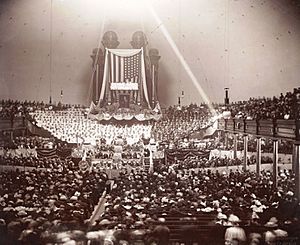
Wilford Woodruff passed away in San Francisco, California, on September 2, 1898, after a bladder surgery. His son-in-law, Lorenzo Snow, became the next church president. Woodruff was buried at the Salt Lake City Cemetery.
Woodruff's journals are a very important part of LDS Church history. He kept a daily record of his life and activities within the church, starting in 1835. An editor of his published journals said that Woodruff was "perhaps, the best chronicler of events in all the history of the Church." His diaries are considered "one of the significant records of 19th-century Mormonism." In addition to his diary, Woodruff wrote over 12,000 letters during his life.
Woodruff was an Assistant Church Historian from 1856 to 1883. He then became the church's eleventh official Church Historian from 1883 to 1889. He and his assistants collected and edited historical documents from the lives of Joseph Smith and Brigham Young. They also wrote biographies of church leaders.
Woodruff's teachings as an apostle were studied in church classes in 2006.
Images for kids
See also
 In Spanish: Wilford Woodruff para niños
In Spanish: Wilford Woodruff para niños
- Smoot–Rowlett Family
- Clara W. Beebe, one of Woodruff's daughters


